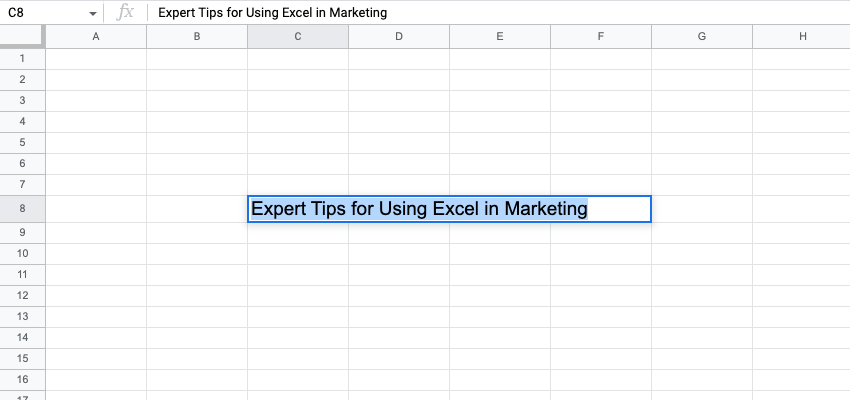Show:
Expert Tips for Using Excel in Marketing
Marketing. It’sIt’s a data-driven field constantly changing, evolving, and growing. As a result, marketing professionals need to be well-versed in various tools and software to succeed. Excel is one of the most commonly used software programs in marketing, yet it is also one of the most misunderstood. While Excel has a reputation for being difficult to use, the truth is that it is a potent tool that can streamline marketing processes and make data-driven decisions. In fact, with a little bit of practice, anyone can learn to use Excel like a pro.

Here are some expert tips for using Excel in marketing:
Understand the Regression Analysis Tool
This tool can help you understand how your marketing efforts impact your sales. You’llYou’ll need to input data about your marketing campaigns and sales results to use this tool. Then, you’ll need to run the regression analysis. This will produce a line of best fit that you can use to understand the relationship between your marketing efforts and sales results.
The R2 (Coefficient determination) value will tell you how well your marketing efforts predict sales. A value of 1.0 means that your marketing efforts are perfectly predicting sales. On the other hand, a value of 0.5 means that your marketing efforts only somewhat predict sales. And a value of 0 means that your marketing efforts are not predicting sales.
Learn How to Use the VLOOKUP Function
If you’re not taking advantage of the VLOOKUP function, you’re missing out on a valuable tool that can save you time and improve your efficiency. VLOOKUP stands for “vertical lookup.” It allows you to search for data in a table by looking up values in a column. For example, let’s say you have a list of customer names and ID numbers in one column, and you want to find the customer’s information in another column quickly. With VLOOKUP, you can enter the customer’s ID number, and Excel will search the entire table for that number. Once it finds a match, it will return the corresponding data from the other column. It saves you hours spent manually searching through data.
As a beginner, you may need all the information regarding this function. That is where research comes in. Look for resources online guiding users on how to use VLOOKUP formula in excel like a pro. Take your time in understanding the commands and practice often. Also, use the VLOOKUP function to find data in other worksheets. You’llYou’ll need to enter the sheet name followed by an exclamation point to do this.
Use Excel to Automate Repetitive Tasks
Any marketer knows that repetitive tasks can quickly eat up valuable time that could be spent on more strategic tasks. Fortunately, there are many ways to automate these tasks using Excel macros or third-party plugins. It can free up time so that you can focus on more important tasks. For example, let’s say you want to create a report showing the results of your latest marketing campaign. Usually, this would involve manually extracting data from multiple sources and then inputting it into Excel. However, using some basic coding techniques, you can automate this process so that Excel does all the work for you. This not only saves you time but also helps to ensure accuracy and consistency in your reporting. So if you’re looking to free up some time in your marketing schedule, consider using Excel to automate some of your repetitive tasks.
By embracing this feature, there would be no more tedious tasks. The writers over at Chronicles of Data can explain how A.I. and automation are the wave of the future in lots of business aspects, and marketing isn’t falling behind. Make sure to get on the bandwagon before the trend passes by. Who knows, with this new technology, you might even be able to save money and time. So don’t wait any longer – start using Excel like a pro and see the results for yourself!

Use Excel to Track Your Marketing Campaigns
Marketing campaigns can be a lot of work to keep track of, but using Excel can help make the process easier. With Excel, you can create a spreadsheet with all of the necessary information for each campaign, including the date, time, and location of the campaign, as well as the target audience. You can also use Excel to track your progress over time, ensuring that each campaign gets the desired results. In addition, Excel can help you to budget your marketing campaigns more effectively, allowing you to allocate your resources in the most efficient way possible.
Create a Pivot Table
Pivot tables are one of the most powerful features in Excel. Summarizing data in a concise and easy-to-read format can be a valuable tool for marketing professionals. Creating a pivot table is relatively simple: select the data you want to include, click on the “Insert” tab and choose “Pivot Table.” From there, you can select the fields you want to include in your table and how you want to summarize the data. For example, you could create a pivot table that shows the total sales for each product category or the average customer satisfaction rating for each department. Pivot tables are also very flexible; you can easily add or remove fields and change the summary function without starting from scratch.
Create Histograms to Visualize Your Data
Histograms are a great way to visualize data in Excel, and they can be especially helpful in marketing. Histograms help you to see the distribution of data, which can be very useful in marketing campaigns. For example, you can use a histogram to see how many people responded to your campaign, what time of day they responded, and what channels they used. You can also use histograms to track conversions over time or to compare conversion rates between different campaigns. To create a histogram in Excel, select the data you want to visualize, click the “Insert” tab, and select “Histogram.” You’llYou’ll then be able to customize your histogram to suit your needs. If you’re looking for a quick and easy way to visualize your marketing data, consider using histograms in Excel.
Excel can be a valuable tool for marketing professionals. Understanding some of the basics of Excel allows you to easily keep track of critical data and create compelling reports and presentations. However, Excel is also a complex program with many features, so it’s essential to understand how to use it effectively before diving in. With a little practice, you’ll be able to take full advantage of all that Excel offers.

 Return to Previous Page
Return to Previous Page








